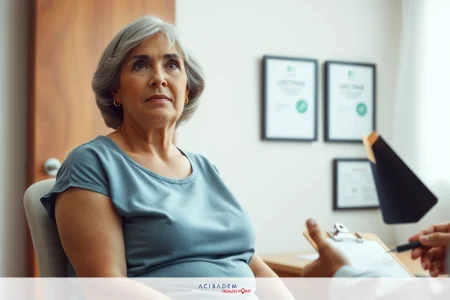Hip and Knee Pain On One Side Causes
Hip and Knee Pain On One Side Causes Do you feel pain in your hip or knee on just one side? It’s important to know why this happens for the right treatment. These include injuries, arthritis, and even some nerve problems.
This guide will look at the main reasons and signs of pain in just one hip or knee. It aims to help you understand your health better.
Understanding Hip and Knee Discomfort
Hip and knee pain can make everyday tasks hard. It can also cause ongoing pain. Knowing what causes it helps in managing it better.
What Constitutes Hip Pain on One Side?
Hip pain on one side comes from the muscles and bones around the hip. It can be caused by muscle strain, ligament injuries, or diseases. Finding out why it hurts requires a detailed check-up and tests.
Defining Knee Pain on One Side
Knee pain on one side often comes from problems in the knee or nearby tissues. Things like meniscal tears, ligament sprains, or arthritis can cause it. It’s important to know the symptoms and causes to find the right treatment.
Common Joint Structures Involved
The hip and knee have many complex parts that can cause pain. Important parts include:
- Cartilage: A smooth tissue that makes moving the joints pain-free.
- Ligaments: Tough bands that connect bones, keeping the joint stable.
- Tendons: These connect muscles to bones, helping with movement and control.
- Bursae: Fluid-filled sacs that lessen friction in moving parts of the joints.
Knowing about these parts and their roles helps in finding and treating hip and knee pain.
Hip and Knee Pain Symptoms
It’s important to know about hip and knee pain symptoms. This helps spot health problems early. Knowing the signs of joint pain can lead to quick medical help and right treatment.
Identifying Hip Pain Symptoms
Hip pain can show in different ways. Look out for these signs:
- Sharp or Dull Pain: Pain can be sharp or a dull ache, depending on the cause.
- Groin Discomfort: You might feel pain deep in the groin or over the hip joint’s outside.
- Reduced Mobility: The hip might not move much, making it hard to walk or bend.
- Stiffness: The hip gets stiff, especially after sitting or lying down for a long time.
Recognizing Knee Pain Symptoms
Knee pain symptoms are similar to hip pain but can vary. Watch for these signs:
- Swelling and Inflammation: Swelling around the knee that feels warm.
- Pain with Movement: Pain gets worse with activities like walking or climbing stairs.
- Instability: You might feel like the knee could give out or buckle.
- Joint Stiffness: The knee gets stiff when you bend or straighten it, and you might hear a creaking sound.
Common Causes of Hip and Knee Pain on One Side
Muscle imbalances often cause one-sided pain. This happens when some muscles are too tight or weak. For example, tight hip flexors and weak glutes can make one side hurt.
Injuries are a big reason for one-sided pain. Healthline says things like sprains, strains, or tears can cause a lot of pain. Also, broken bones and dislocations are serious and need quick help to avoid long-term pain.
Arthritis is another big cause of pain on one side. The Arthritis Foundation says it’s a long-term condition that can make one hip or knee hurt more than the other. Osteoarthritis is common in older people and can hit one side harder. Rheumatoid arthritis can also affect one side more than the other.
To wrap it up, knowing why one side hurts involves looking at muscle issues, injuries, and joint diseases. These factors show why finding the right treatment is key to feeling better and moving better.
Injury-Related Causes
It’s important to know why hip and knee pain happens. Soft tissue injuries, fractures, and dislocations are common causes. These issues can make moving these joints hard.
Soft Tissue Injuries
Soft tissue injuries hurt muscles, ligaments, and tendons around the hip and knee. They can come from overdoing it, a sudden hit, or stretching too much. You might see swelling, bruising, and moving the joint becomes hard.
Fractures and Dislocations
Fractures and dislocations mean a bone break or a joint out of place. They can happen from big falls, car crashes, or sports injuries. The pain from these injuries is sharp and needs quick doctor help.
Here is a detailed comparison of common symptoms and treatments for these injury types:
| Injury Type | Symptoms | Common Treatments |
|---|---|---|
| Soft Tissue Injuries | Swelling, bruising, reduced mobility | Rest, ice, compression, elevation (RICE), physical therapy |
| Fractures | Severe pain, visible deformity, inability to bear weight | Immobilization, surgery, pain management |
| Dislocations | Intense pain, joint instability, visible displacement | Reduction, immobilization, rehabilitation exercises |
Arthritis and Joint Issues
Arthritis and joint issues make people feel bad and move less easily. They can cause a lot of pain. The most common types include osteoarthritis, rheumatoid arthritis, and related problems like bursitis and tendonitis.
Osteoarthritis
Osteoarthritis happens when the cartilage wears out. It mostly affects people over 50. They may feel pain, stiffness, and swelling in their joints.
It can make joints wear out a lot, especially in the hips and knees, says the Arthritis Foundation.
Rheumatoid Arthritis
Rheumatoid arthritis is when the immune system attacks the lining around the joints. This causes inflammation and can hurt the joints. The American College of Rheumatology says finding it early and treating it is key to stopping it from getting worse.
Bursitis and Tendonitis
Bursitis and tendonitis happen when the bursae and tendons get inflamed. They can come from doing the same thing over and over. This can make a lot of pain and make moving hard.
The BMJ journals talk about ways to treat these to help with the pain and make moving easier.
Here is a table with important info about these conditions:
| Condition | Cause | Primary Symptoms | Primary Affected Areas |
|---|---|---|---|
| Osteoarthritis | Wear and Tear of Cartilage | Pain, Stiffness, Swelling | Hips, Knees |
| Rheumatoid Arthritis | Autoimmune Disorder | Inflammation, Joint Damage, Pain | Multiple Joints |
| Bursitis | Inflammation of Bursae | Pain, Swelling, Redness | Hips, Knees, Shoulders |
| Tendonitis | Inflammation of Tendons | Pain, Tenderness, Reduced Range of Motion | Shoulders, Knees, Elbows |
Muscle Imbalance and Overuse
Muscle imbalance can hurt your hips and knees, especially if you do the same thing over and over. The International Journal of Sports Physical Therapy says it can cause overuse injuries. This happens when joints and tissues get stressed out.
When some muscles get stronger than others, it messes up how your body moves. This puts more stress on your hips and knees. It can lead to overuse injuries.
Articles in the Physical Therapy journal talk about how to fix this. You need to make weaker muscles stronger and stretch tight ones. This helps balance your body and takes pressure off your joints.
The Journal of Orthopaedic & Sports Physical Therapy has studies on muscle imbalance. They show how it affects hips and knees. These studies say we need to fix these imbalances to avoid more problems. Here’s a look at some common overuse injuries and how muscle imbalance affects them:
| Condition | Caused by Muscle Imbalance | Impact on Hip and Knee Strain |
|---|---|---|
| Patellofemoral Pain Syndrome | Weak quadriceps and tight hamstrings | Increased pressure on knee joint |
| IT Band Syndrome | Tight iliotibial band and weak hip abductors | Hip and knee inflammation |
| Shin Splints | Imbalance between calves and anterior tibialis | Strain on lower leg muscles and knee |
Neurological Causes of Hip and Knee Pain
Hip and knee pain on one side can come from many neurological causes. Pinched nerves and sciatica are big contributors to nerve pain in joints. Knowing these causes helps in finding the right treatment.
Pinched Nerves
Pinched nerves happen when nerves get too much pressure from bones, cartilage, muscles, or tendons. This pressure stops the nerve from working right. It leads to pain, tingling, numbness, or weakness in the area.
A pinched nerve in the lower back can cause pain in the hip and knee.
Sciatica
Sciatica is pain that goes down the sciatic nerve from the lower back to the hips and legs. It usually affects only one side. The pain can be mild or very sharp and burning.
The American Chronic Pain Association says sciatica is often from a herniated disk or bone spur pressing on the nerve. To manage sciatica, you might need physical therapy, medicine, or surgery.
Knowing the right diagnosis and understanding these causes is key to managing pain. It helps improve life quality for those with hip and knee pain.
Treatment Options for Unilateral Hip and Knee Pain
Dealing with pain in just one hip or knee needs a mix of treatments. It’s important to know the different ways to help manage pain and get better.
Physical Therapy
Physical therapy is key for treating one-sided hip and knee pain. The American Physical Therapy Association says exercises help with strength, flexibility, and balance. A special plan can lessen pain, lower swelling, and make joints work better.
Medication and Pain Management
Medicine is vital for easing hip and knee pain symptoms. The FDA has approved many drugs for both short-term and long-term pain relief. Doctors might prescribe NSAIDs, corticosteroids, or opioid painkillers, depending on how bad the pain is and the patient’s health history.
Surgical Options
In the end, treating one-sided hip and knee pain means using a mix of physical therapy, medicine, and surgery. Working with doctors to create a plan is key for getting better and living a good life.
FAQ
What constitutes hip pain on one side?
Hip pain on one side means you feel pain in the hip joint or muscles on just one side. This pain can come from injuries, arthritis, or nerve problems.
What defines knee pain on one side?
Knee pain on one side means you feel pain in just one knee. It can happen from injuries, overuse, arthritis, or other issues with the joint.
What are common joint structures involved in hip and knee discomfort?
Common parts that can hurt in hip and knee joints include bones, cartilage, ligaments, tendons, and muscles. These can hurt if they get damaged or inflamed.












